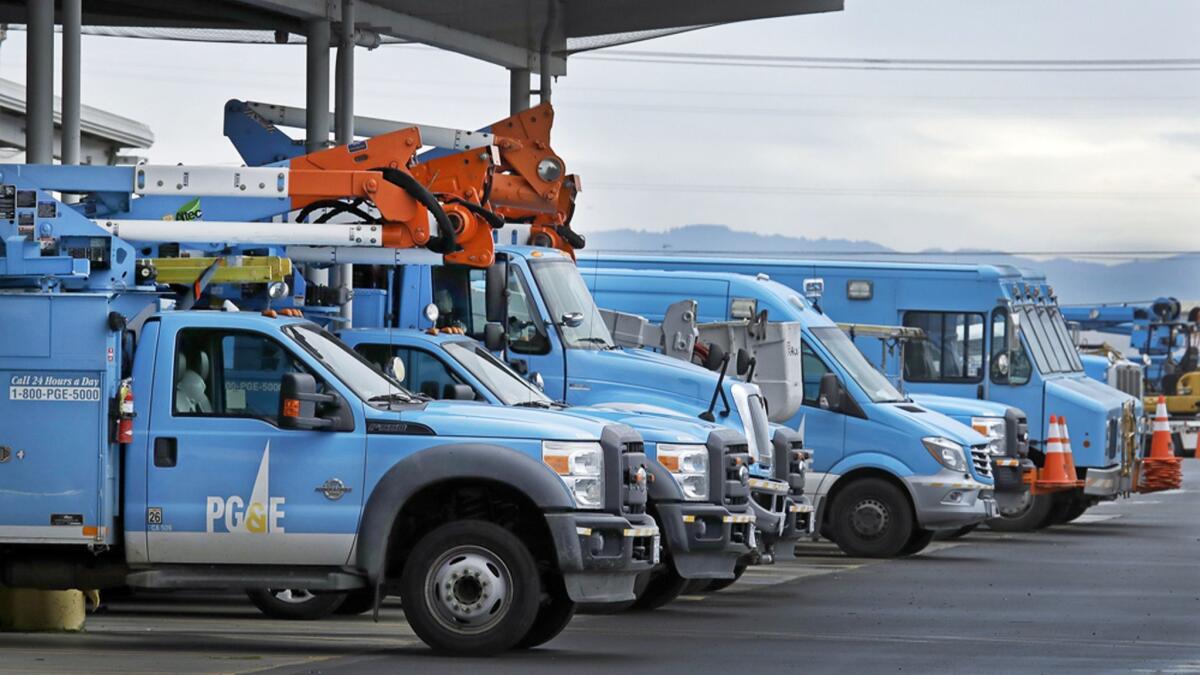PG&E faces anger, mistrust, questions over power outages: ‘It is excessive’

- Share via
A massive planned power outage that could affect millions in Northern and Central California is sparking frustration and skepticism in some areas over whether the extreme action is the best way to reduce fire risk.
Pacific Gas & Electric began turning off the power at midnight to an expected 800,000 customers to reduce the risk of wildfires because of windy conditions. Some of California’s worst blazes have been sparked by power lines, including last year’s Paradise fire and the 2017 wine country fires.
But such a widespread shutdown has some questioning whether PG&E is going too far.
State Sen. Jerry Hill (D-San Mateo), whose district lies within the blackout area, acknowledged there is a fire danger that requires the shutting down of some power lines, but he called the extent of the possible outage troubling.
“I think it is excessive,” said Hill, a longtime critic of the utility. ”PG&E clearly hasn’t made its system safe. These shutdowns are supposed to be surgical. But shutting down power to 800,000 people in 31 counties is by no means surgical.”
Hill, who convened a recent hearing on the Public Utility Commission’s oversight of PG&E, called on the state agency to do a “root cause” analysis of the electrical shutdowns.
“This cannot be something that can be acceptable nor long-term,” Hill said. “This is Third World, and we are not.”
At the Ukiah Senior Center in Mendocino County, executive director Diana Clarke also was concerned.
“People have been on pins and needles all day because of the uncertainty,” she said. “They don’t know if they should go out and buy supplies, and especially with seniors, they don’t have a lot of extra money.”
There is a deep sense of frustration and skepticism in the community at the idea of losing power to protect against wildfires.
“PG&E should have been doing the proper maintenance for the last decade,” Clarke said. “This wouldn’t have been necessary [if they had], and I think that’s what has got everyone so angry and frustrated with PG&E right now. This is a crisis of PG&E’s making.”
Millions of Californians could spend days without power as the state’s largest utility continues shutting off electricity in a desperate attempt to avoid wildfires sparked by windblown power lines.
Assembly Republican leader Marie Waldron of Escondido said PG&E’s announcement is a sign of how far the state has fallen behind in efforts to prevent catastrophic wildfires.
“This is the frustrating result of decades of forest mismanagement and aging energy infrastructure,” Waldron said. “These shutoffs highlight the need to invest in vegetation management, update our energy grid and help Californians harden their homes against wildfires.”
PG&E has defended its decision, though, saying it is acting to prevent a repeat of fatal fires.
Nearly all of California’s biggest and most deadly wildfires have occurred in the last 20 years, with many of them being sparked by electrical grid failures.
It’s that liability that pushed PG&E into bankruptcy this year and has raised concerns that utilities may become more eager to shut off power to avoid potential catastrophe, even when the risk is minimal.
Scores of lawsuits have been filed on behalf of people whose loved ones were killed, whose pets disappeared into the blazing wilderness and who lost everything they owned. They accuse the utility of failing to properly maintain its equipment.
Gov. Gavin Newsom defended PG&E’s plans for the intentional power shutdowns.
“The reality is that we want to protect people. We want to make sure people are safe. This is what PG&E thinks is in the best interest of their customers and ultimately for this region and the state,” the governor said.
“It is a massive inconvenience,” he added. “No one wants to see this happen. But it is a public safety issue.”
Even before this week, the power shutoffs generated debate, with some residents saying they create a whole new set of dangers for them as they try to watch for news about potential fires. There is also heightened concern for those with health issues who rely on electronic medical equipment for survival.
Critics worry that communications and evacuations will be hampered if the power is out, especially if traffic signals don’t work and cellphone service is affected.
The power in Lilli Heart’s lakefront home in Cottonwood, in Shasta County, went out at 12:30 a.m. Wednesday.
At first her Facebook posts were upbeat, even cheerful. She’d lost everything in the Camp fire 11 months earlier, so what’s a little darkness to a 73-year-old survivor who fled Paradise and started over?
“Ok power now down glad I just got my bowl of ice cream eating by flashlight,” she wrote and signed off with a heart emoji.
Eleven or so hours later, she was still mostly holding her own: “The wind is certainly strong today,” she posted to Facebook. “My Hummingbirds are struggling to get to their feeders. They are freaking out. Cold here too. So with no electricity or propane I used what was left to get some hot water out of the tap the last of it to make more nectar for them.”
And another heart.
By lunchtime, though, all bets were off. She’d swung by the vet to pick up medication for her ailing rescue cat and his cancerous thyroid. She headed to the market to pick up groceries, knowing the place was cash only and all she had on hand was $15.
She answered her cellphone and let loose on Pacific Gas & Electric Co. and its crippled electrical grid.
“I’m really mad at them,” Heart fumed. “We’ve had high winds in California for years and they’ve never shut down the power. It’s unconscionable.… They’re talking about possibly six days. I have nine orders today. I can’t fill my orders. And that’s just me. Some people are on oxygen. I think the governor needs to step in and do something.”
Once the fire weather subsides, PG&E employees will inspect the grid on-site and electronically before turning the power back on, a company official said.
It took the utility less than a day to restore power to customers during a three-county shutoff last weekend and during another in September, the company said in a statement.
At a news conference Tuesday, Oakland Mayor Libby Schaaf expressed concern over PG&E’s timeline to restore power but said she was grateful they had been given time to prepare.
“We expect PG&E to do everything to minimize the impact to residents,” Schaaf said. “The idea of five days without electricity is devastating. We fully expect that to be a worst-case scenario.”
More to Read
Sign up for Essential California
The most important California stories and recommendations in your inbox every morning.
You may occasionally receive promotional content from the Los Angeles Times.
















